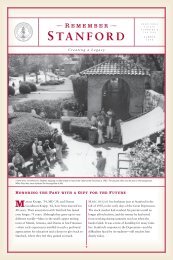Stanford's Endowment: Frequently Asked Questions - Giving to ...
Stanford's Endowment: Frequently Asked Questions - Giving to ...
Stanford's Endowment: Frequently Asked Questions - Giving to ...
You also want an ePaper? Increase the reach of your titles
YUMPU automatically turns print PDFs into web optimized ePapers that Google loves.
Stanford’s<br />
<strong>Endowment</strong><br />
<strong>Frequently</strong> <strong>Asked</strong><br />
<strong>Questions</strong>
“...it shall constitute the foundation and endowment<br />
for the University herein provided, and upon the<br />
trust that the principal thereof shall forever remain<br />
intact, and that the rents, issues, and profits thereof<br />
shall be devoted <strong>to</strong> the foundation and maintenance<br />
of the University hereby founded and endowed, and<br />
<strong>to</strong> the uses and purposes herein mentioned.”<br />
Leland and Jane Lathrop Stanford<br />
Stanford University Founding Grant, 1885<br />
Stanford’s <strong>Endowment</strong><br />
<strong>Frequently</strong> <strong>Asked</strong> <strong>Questions</strong><br />
What is the endowment?<br />
ENDOWMENT REFERS TO ASSETS THAT ARE INVESTED FOR THE LONG TERM AND INTENDED<br />
<strong>to</strong> provide a permanent source of financial support for the university. This is in contrast<br />
<strong>to</strong> expendable funds, which are typically used for immediate needs. Stanford’s<br />
original endowment was created in 1885 by Leland and Jane Stanford.<br />
Over the years, thousands of donors have established endowed funds for scholarships,<br />
fellowships, professorships, and many other purposes. Today, Stanford’s<br />
endowment comprises nearly 7,000 individual funds, each one named and used in<br />
accordance with the donor’s wishes.<br />
When a donor creates an endowed fund, the gift “buys shares” in Stanford’s Merged<br />
Pool (MP), which operates similarly <strong>to</strong> a mutual fund. The value of the shares changes<br />
depending on investment returns. Each year the Board of Trustees sets a payout<br />
rate, much like a dividend, for MP shares. Payout is the amount available <strong>to</strong> be spent<br />
annually for the fund’s designated purposes. (See “How does Stanford determine its<br />
endowment payout?” for more information.)<br />
2 COVER PHOTOS AND ABOVE: L. A. CICERO / STANFORD NEWS SERVICE
How big is Stanford’s<br />
endowment?<br />
How does Stanford<br />
determine its<br />
endowment payout?<br />
L. A. CICERO/STANFORD NEWS SERVICE<br />
AS OF AUGUST 31, 2012 (THE END OF STANFORD’S FISCAL YEAR), THE VALUE OF THE<br />
endowment was $17 billion, an increase of 3.2 percent over the previous year.<br />
(The increase reflects the impact of investment returns plus new endowment gifts<br />
and transfers, minus the payout <strong>to</strong> support university operations.) “Our endowment<br />
is still smaller than preceding the 2008–09 financial downturn, and we continue <strong>to</strong> be<br />
concerned about the possible reductions in federal research funding and an investment<br />
downturn driven by global economic malaise,” explains Randy Livings<strong>to</strong>n, vice<br />
president for business affairs and chief financial officer.<br />
Stanford is among the few private American universities that offer need-blind undergraduate admission.<br />
STANFORD’S BOARD OF TRUSTEES APPROVES THE PAYOUT RATE ANNUALLY, TYPICALLY<br />
targeting a long-term average yearly distribution of about 5.5 percent from endowed<br />
funds. This target average takes in<strong>to</strong> account the long-term viability of the fund,<br />
despite annual fluctuations in the fund’s value. The Board of Trustees has determined<br />
that the target is a prudent amount that balances the needs for ongoing support with<br />
perpetual preservation of the endowed funds.<br />
The payout does not depend on particular components of return (like “income” or<br />
“appreciation”) because the university invests its endowment for <strong>to</strong>tal overall return.<br />
Thus, unless the donor provides otherwise, payout can be satisfied from a fund’s income,<br />
appreciation, and, if those amounts are insufficient, from principal or “his<strong>to</strong>ric<br />
gift value.” In all events, the Board of Trustees is careful <strong>to</strong> calibrate payout with the<br />
goal of enabling endowed funds <strong>to</strong> support their purposes in perpetuity.<br />
The university uses a smoothing formula <strong>to</strong> cushion the endowment against market<br />
swings that can influence investment returns from year <strong>to</strong> year. The smoothing formula<br />
produces an actual dollar payout that is far steadier than what would result if<br />
the payout were set at a fixed percentage of the endowment value (which would then<br />
fluctuate—sometimes dramatically—with the market). The formula includes a weighted<br />
combination of the current year’s payout rate and the target payout (the weighting<br />
is now set at 70/30, with a target payout of 5.5 percent), and generates a payout rate<br />
that trails the target payout in periods of exceptional investment performance and<br />
exceeds the target rate during prolonged investment downturns. The result is approved<br />
by the Board of Trustees each February, enabling the university <strong>to</strong> plan ahead<br />
for the following fiscal year’s budget (September through August).<br />
ENDOWMENT FAQ | STANFORD UNIVERSITY 3
What percentage of<br />
Stanford’s expenses is<br />
funded through the<br />
endowment?<br />
How does Stanford’s<br />
endowment measure up?<br />
4<br />
L. A. CICERO/STANFORD NEWS SERVICE<br />
IN FISCAL YEAR 2012, ENDOWMENT PAYOUT COVERED APPROXIMATELY 23 PERCENT OF<br />
Stanford’s operating expenses. Solid investment management, a prudent payout strategy,<br />
and robust support from donors have meant that Stanford has been able <strong>to</strong> grow<br />
this number from 9 percent in 1992. Still, Stanford must fund more than two-thirds of<br />
its operating expenses—which were $3.8 billion in fiscal year 2012—from government<br />
grants and contracts; student tuition and fees; nongovernment grants; and gifts from<br />
alumni, parents, and friends. Over time, Stanford seeks <strong>to</strong> increase the percentage<br />
of operating expenses covered by endowment payout, thus providing a permanent<br />
source of funding for academic programs and financial aid.<br />
Stanford confers approximately 3,000 graduate degrees each year.<br />
ENDOWMENT VALUES FOR HARVARD, PRINCETON, AND YALE ON JUNE 30, 2012 (THE END<br />
of their fiscal years), were $30.7 billion, $17.0 billion, and $19.3 billion, respectively.<br />
Those institutions’ endowments are significantly larger than Stanford’s relative <strong>to</strong><br />
their expenses.<br />
50<br />
40<br />
30<br />
20<br />
10<br />
0<br />
Percentage of Expenses Covered by <strong>Endowment</strong><br />
HARVARD<br />
33%<br />
PRINCETON<br />
46%<br />
YALE<br />
36%<br />
Sources: Harvard Gazette, Prince<strong>to</strong>n Profile, Yale News<br />
STANFORD<br />
23%
L. A. CICERO/STANFORD NEWS SERVICE<br />
1 The Merged Pool represents the primary<br />
investment vehicle of Stanford’s endowment.<br />
2 The S&P 500 represents 500 of the largest compa-<br />
nies in the U.S. economy, a broad snapshot of the<br />
U.S. equity market.<br />
3 The MSCI All Country World Investable Market<br />
index tracks 9,000 s<strong>to</strong>cks in 45 countries.<br />
4 Represents a passively managed portfolio of 60%<br />
MSCI ACWI and 40% Barclays Capital Aggregate<br />
Bond index, a traditional institutional benchmark.<br />
Can Stanford dip deeper<br />
in<strong>to</strong> the university’s<br />
endowment <strong>to</strong> cover more<br />
expenses?<br />
Stanford enrolls about 6,900 undergraduate students.<br />
10<br />
8<br />
6<br />
4<br />
2<br />
0<br />
Stanford vs. Market Benchmarks—
L. A. CICERO/STANFORD NEWS SERVICE<br />
Can Stanford’s<br />
land be sold <strong>to</strong> pay<br />
for expenses?<br />
6<br />
LELAND AND JANE STANFORD ANTICIPATED THAT SELLING LAND TO MEET IMMEDIATE<br />
needs might be a temptation, so in the Founding Grant they required that none of<br />
the land of their Palo Al<strong>to</strong> farm ever be sold. They did so because they believed those<br />
lands would provide for the long-term viability of the university. Their farm comprises<br />
more than three-quarters of Stanford’s current landholdings.<br />
Over the years, Stanford’s Board of Trustees has chosen <strong>to</strong> apply the same principles<br />
of stewardship <strong>to</strong> the rest of the lands that make up Stanford’s campus. The land is<br />
held in trust <strong>to</strong> carry out the aims of the Founding Grant: <strong>to</strong> support the university,<br />
either directly for academic purposes or indirectly through the generation of income<br />
for those purposes.<br />
Today, Stanford University owns 8,180 acres of contiguous land spread over six political<br />
jurisdictions—four municipalities (Palo Al<strong>to</strong>, Menlo Park, Woodside, and Por<strong>to</strong>la<br />
Valley) and unincorporated land in two counties (Santa Clara and San Mateo).<br />
The central part of Stanford’s land is home <strong>to</strong> academic buildings and support facilities,<br />
including classrooms and labora<strong>to</strong>ries, athletic and recreation facilities, student<br />
and faculty housing, and the SLAC National Accelera<strong>to</strong>r Labora<strong>to</strong>ry. Two hospitals, a<br />
shopping center, and a commercial research park are also located on Stanford land.<br />
But after more than a century of dynamic operation and growth, nearly two-thirds of<br />
Stanford’s land remains open space or is only lightly developed.<br />
Keeping the land intact has allowed the university <strong>to</strong> retain one of the country’s most<br />
magnificent campuses, which is a strong magnet for potential students, faculty, and<br />
researchers. And even the undeveloped land serves important academic purposes.<br />
For instance, the Jasper Ridge Biological Preserve covers 1,189 acres of the campus<br />
and has been the site of many fundamental studies in ecology, hydrology, geology,<br />
and archaeology.<br />
The university’s Jasper Ridge Biological Preserve supports an average of 60<br />
research projects each year.
Do small gifts make<br />
a difference?<br />
How much of Stanford’s<br />
expenses are covered by<br />
tuition? What role does<br />
financial aid play?<br />
L. A. CICERO/STANFORD NEWS SERVICE<br />
Tuition covers only about two-thirds of the real costs of a Stanford<br />
undergraduate education.<br />
L. A. CICERO/STANFORD NEWS SERVICE<br />
YES. LARGE GIFTS AND GRANTS OFTEN TARGET SPECIFIC NEW VENTURES OR ARE OTHERwise<br />
restricted. That makes even quite small gifts, which generally have few restrictions,<br />
enormously valuable <strong>to</strong> Stanford. Annual, expendable gifts that can be used<br />
in their entirety <strong>to</strong> meet immediate needs are an essential complement <strong>to</strong> gifts of<br />
endowment.<br />
Last year, most gifts made <strong>to</strong> the university were under $1,000. But <strong>to</strong>gether, these<br />
gifts added up <strong>to</strong> millions of dollars that may be used for need-based financial aid,<br />
academic programs, solutions-oriented research in<strong>to</strong> global problems, and programs<br />
such as the Haas Center for Public Service.<br />
The current Stanford community of scholars includes 4 Pulitzer Prize winners, 19 Nobel laureates, 24 MacArthur<br />
fellows, and hundreds of members of the national academies. (LEFT: The late Arthur Kornberg, professor<br />
emeritus of biochemistry, and his son, Roger, professor of structural biology, are both Nobel recipients.<br />
RIGHT: Computer scientist Daphne Koller is a MacArthur Fellowship award winner.)<br />
TUITION ACCOUNTS FOR JUST 15 PERCENT OF UNIVERSITY REVENUES IN A GIVEN YEAR.<br />
What’s more, tuition covers only about two-thirds of the real costs associated with<br />
a Stanford undergraduate education. Thus, even those paying “full price” are not<br />
actually paying the full cost of four years at Stanford. From the university’s first days,<br />
a Stanford education has been subsidized by the generosity of the founders, alumni,<br />
parents, friends, and other donors.<br />
Most students do not even pay full price, let alone the real costs. In fact, half of all<br />
Stanford undergraduates receive need-based aid directly from the university.<br />
Stanford committed <strong>to</strong> substantial enhancements of its financial<br />
aid program just as the economic recession led <strong>to</strong> increased<br />
need among students and their families. As a result,<br />
the university’s financial aid budget has more than doubled<br />
since 2005–06. The policy changes have greatly reduced the<br />
percentage of seniors graduating with student loans and<br />
have allowed us <strong>to</strong> remain competitive with peer institutions.<br />
To ensure that Stanford remains accessible <strong>to</strong> talented<br />
students from all backgrounds, the university is looking <strong>to</strong><br />
increase support for financial aid from The Stanford Fund and<br />
<strong>to</strong> continue growing the endowment for scholarships.<br />
ENDOWMENT FAQ | STANFORD UNIVERSITY 7
For more information on Stanford’s finances,<br />
please see the university’s annual report:<br />
annualreport.stanford.edu.<br />
For more information, please contact:<br />
Office of Development<br />
The Frances C. Arrillaga Alumni Center<br />
326 Galvez Street<br />
Stanford, CA 94305-6105<br />
T 800.227.8977<br />
Printed on recycled paper | WPEND3000Q0113<br />
L. A. CICERO/STANFORD NEWS SERVICE


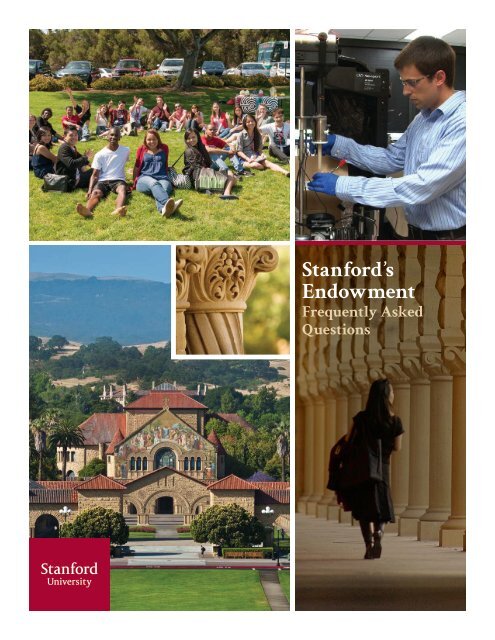
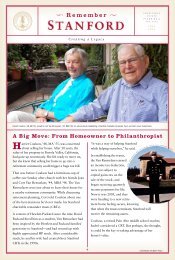
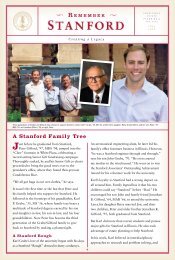
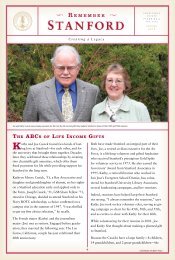
![Leadership Giving: Stanford Reunion Campaigns 2013 [PDF]](https://img.yumpu.com/19129379/1/190x245/leadership-giving-stanford-reunion-campaigns-2013-pdf.jpg?quality=85)
![Creating a Charitable Lead Annuity Trust [PDF] - Giving to Stanford](https://img.yumpu.com/19129374/1/190x245/creating-a-charitable-lead-annuity-trust-pdf-giving-to-stanford.jpg?quality=85)
![Leadership Giving to The Stanford Fund [PDF] - Giving to Stanford ...](https://img.yumpu.com/19129353/1/190x245/leadership-giving-to-the-stanford-fund-pdf-giving-to-stanford-.jpg?quality=85)
![Undergraduate Financial Aid: A Defining Commitment [PDF]](https://img.yumpu.com/19129351/1/190x245/undergraduate-financial-aid-a-defining-commitment-pdf.jpg?quality=85)
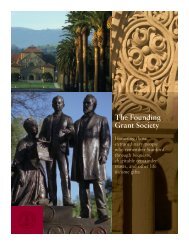
![The Stanford Fund for Undergraduate Education [PDF] - Giving to ...](https://img.yumpu.com/19129349/1/190x245/the-stanford-fund-for-undergraduate-education-pdf-giving-to-.jpg?quality=85)
![Stanford Interdisciplinary Graduate Fellowships [PDF] - Giving to ...](https://img.yumpu.com/19129346/1/190x245/stanford-interdisciplinary-graduate-fellowships-pdf-giving-to-.jpg?quality=85)
![Donor Advised Funds [PDF] - Giving to Stanford - Stanford University](https://img.yumpu.com/19129344/1/190x245/donor-advised-funds-pdf-giving-to-stanford-stanford-university.jpg?quality=85)
